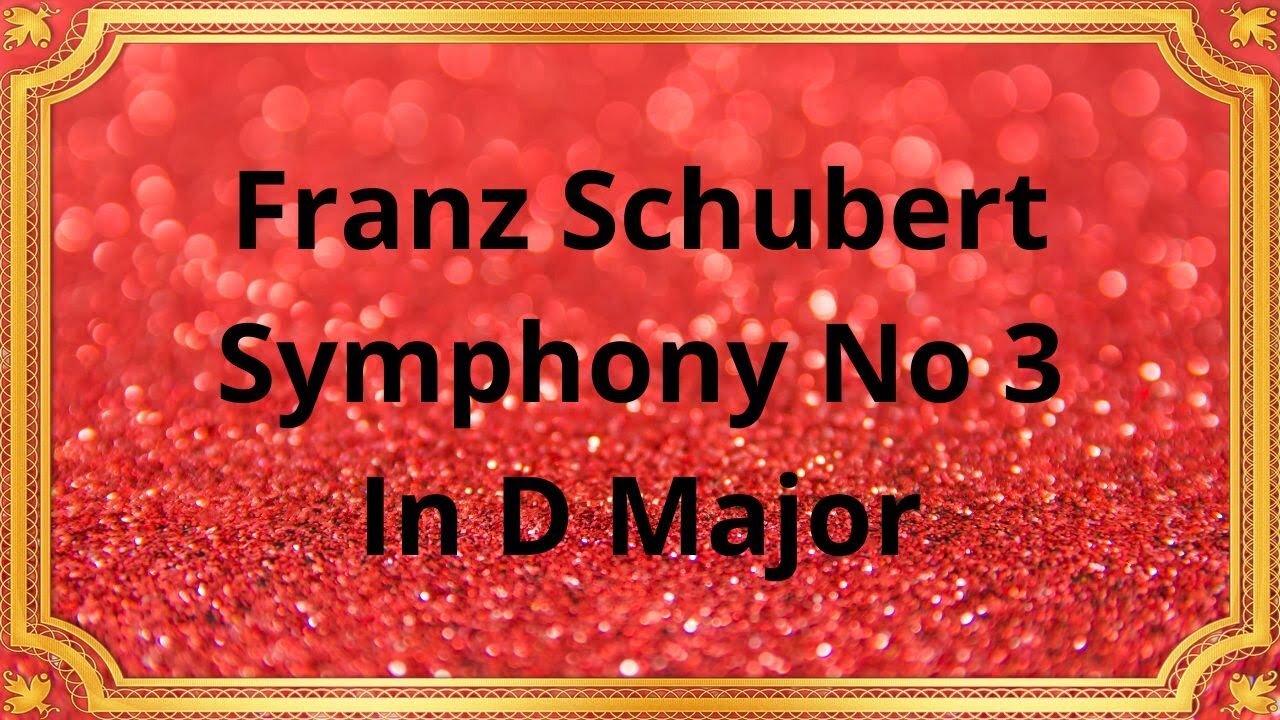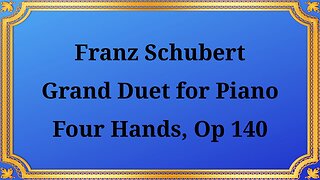Premium Only Content

Franz Schubert Symphony No 3 In D Major
#Schubert #ClassicalMusic #SymphonyNo3 #MusicalComposition #DMajor #Vienna #MusicHistory #MusicAppreciation #19thCenturyMusic #OrchestralMusic #Symphony #VienneseClassicalStyle #RomanticPeriod #MusicGenius #Orchestra #SymphonicWork
Publication date 1951
THE CINCINNATI SYMPHONY ORCHESTRA
Conductor THOR JOHNSON
Franz Schubert, a prominent composer of the Romantic era, left behind a rich and diverse musical legacy. Among his notable works, Symphony No. 3 in D Major stands as a testament to Schubert's compositional genius.
Composed in 1815 when Schubert was just 18 years old, Symphony No. 3 reflects the composer's admiration for the Viennese Classical style popularized by Haydn and Mozart. Schubert's early symphonies, including the third, showcase his ability to blend the classical tradition with his unique melodic gifts, foreshadowing the development of his mature style.
Schubert's Symphony No. 3 is written for a standard symphony orchestra, including winds, strings, and brass instruments. The symphony consists of four movements, adhering to the traditional structure of Classical symphonic compositions:
1. Adagio maestoso – Allegro con brio: The opening movement begins with a majestic and lyrical Adagio introduction, followed by a lively Allegro con brio. Schubert's gift for melody is evident in this movement, as he weaves memorable themes with vibrant orchestration and rhythmic vitality.
2. Allegretto: The second movement is a graceful and charming Allegretto in A major. This delicate dance-like movement showcases Schubert's ability to create a sense of elegance and lightness, while maintaining a deep emotional undercurrent.
3. Menuetto: The third movement, a Menuetto in D minor, presents a contrasting mood with its stately and solemn character. Schubert masterfully balances the rhythmic drive of the dance form with moments of introspection, creating a sense of tension and depth.
4. Presto vivace: The final movement bursts forth with energy and virtuosity. This vivacious Presto showcases Schubert's ability to create thrilling and exuberant music, filled with vibrant orchestral colors and lively melodies.
Schubert's Symphony No. 3 in D Major demonstrates the composer's early mastery of symphonic writing and his ability to infuse classical forms with his own distinctive voice. While paying homage to his predecessors, Schubert's melodic inventiveness and harmonic richness set him apart, foreshadowing the unique musical language he would develop in his later works.
This symphony stands as a testament to Schubert's ability to combine lyricism with structural integrity, showcasing his gift for crafting memorable melodies and his deep understanding of orchestration. Despite being composed at a young age, Symphony No. 3 displays a level of maturity and artistic vision that belies Schubert's youth.
Conclusion:
Franz Schubert's Symphony No. 3 in D Major is a remarkable composition that showcases the composer's early genius and foreshadows the musical brilliance he would achieve in his later works. Through its adherence to classical forms, memorable melodies, and vibrant orchestration, this symphony captivates audiences with its elegance and emotional depth.
Schubert's ability to blend classical traditions with his own unique voice is evident in Symphony No. 3, making it a testament to his enduring musical legacy. As we delve into the enchanting world of this symphony, we are reminded of Schubert's exceptional talent and his lasting impact on the symphonic repertoire.
You have the opportunity to support the channel:
https://destream.net/live/RadSiarAl/donate
https://www.buymeacoffee.com/6355radsiaral
-
 24:30
24:30
Classical music_Music Inspiration
2 months agoFranz Schubert Grand Duet for Piano Four Hands, Op. 140
751 -
 2:43:00
2:43:00
TimcastIRL
3 hours agoTrump Demands IRAN SURRENDER NOW, Mobilizes For WAR, Jets Deployed | Timcast IRL
197K114 -
 LIVE
LIVE
Spartan
10 hours agoPro Halo Player | Ranked Arena breaking in a new controller
836 watching -
 2:34:37
2:34:37
Barry Cunningham
3 hours agoPRESIDENT TRUMP NOW HAS PROOF OF THE FRAUD OF 2020! BIG PHARMA IN TROUBLE! MORE NEWS!
68.8K27 -
 8:25
8:25
MattMorseTV
9 hours ago $1.14 earnedTrump just FLIPPED the SCRIPT.
16.2K24 -
 LIVE
LIVE
BigTallRedneck
2 hours agoCome Chill with the Redneck!
120 watching -
 LIVE
LIVE
TheBeardedBrent
1 hour ago🔴LIVE🔥 | WARZONE | BEADERED THE BOT HUNTER!! | ROAD TO 50 SUBS!!🔥
101 watching -
 1:27:44
1:27:44
Glenn Greenwald
5 hours agoTrump Declares the War in Iran to Be His Own; Journalist Ken Klippenstein on Trump's War Plans, DC Dems, and More | SYSTEM UPDATE #470
117K145 -
 2:42:21
2:42:21
RiftTV/Slightly Offensive
5 hours agoLAPD Shot ME?! Rioters RAN OVER, US Attacking Iran? | The Rift | Guest: Anna Perez + Braeden Sorbo
52.3K12 -
 2:12:14
2:12:14
TubButter
1 day ago $0.19 earnedMy aim is sharper in 1440P Warzone! (Maybe). 😉 Live now! #Warzone #1440p #FunnyFails #TubButter
15.1K